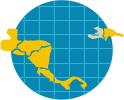This section provides details on the valuation methodology applied in Chapter VI. On the basis of the species coverage, level of detail, consistency of the dataset and probable comparability to prices within the Region, the “Declared U.S. Dollar Value” data from the United States CITES annual reports were used as the basis for calculations of the value of direct exports of CITES-listed animals from the Region. The United States is a major importer and exporter of CITES-listed species and therefore this dataset included price data for a large number of CITES species in trade. Using exporter-reported trade data derived from the CITES Trade Database, the United States price data were extrapolated to calculate the minimum value of reported exports of CITES-listed animals from the Region.
United States price data used
The Declared U.S. Dollar Value is the amount in U.S. dollars declared by the trader at the point of export from or import to the United States on USFWS 3-177 forms. The Declared U.S. Dollar Value data for cleared items (Status = “CL”) provided in the United States CITES annual reports for the years 2008-2012 were used. Both import and export price data were included in the analysis.
On account of limited price data, plants were excluded from the analysis; it is hoped that plant price datasets can be improved in the future to address this issue.
Data for animals were standardised to comply with CITES accepted codes (for further information on CITES codes for terms, sources and units, see the Glossary of terms and http://www.cites.org/eng/notif/2011/E019A.pdf). Unit and source codes were converted or grouped (in the cases of some sources) to allow for more meaningful analysis. All sources and purposes were included in the analysis.
Price per taxon per year (2008-2012) was corrected for inflation by using a conversion factor (see http://www.usinflationcalculator.com/) to express prices as estimates of U.S. dollars in 2012.
The median USD price for each family/unit/source/term combination was calculated. Family-level price data were used so that median prices would be based on a higher number of records, thus providing a more robust price estimate. Furthermore, calculating value at the family level provided value data for a higher proportion of trade records from the Region.
Exporter-reported data from the Region
Trade data were extracted from the CITES Trade Database to determine trade volumes as reported by the Region over the ten year period 2003-2012. All terms, sources and purposes were included.
Calculating value of animal exports from the Region
To estimate the monetary value of direct exports of CITES-listed animal species, the median price value for each family/unit/source/term combination was multiplied by the volume of direct exports reported by the Region.
Where the family median was based on a small number of records within the United States price dataset (<5 records) or where price data were unavailable for a family/unit/source/term combination (e.g. because the United States had not traded in the taxon in question), proxy values were used. An example of a typical proxy would be using the median price for the order/source/unit/term combination or the same family/unit/term combination but for trade in a similar but different source. For those commodities where a suitable proxy could not be found (e.g. there was no comparable proxy with sufficient price records to give a valid estimate), the data were excluded.
The trade dataset included 29,027 trade records, of which 13,485 (46%) were plants. Of the remaining 15,543 animal trade records, valid median price values were calculated for 12,990 trade records. Suitable proxies were identified for the majority of the remaining trade records, with 655 records (<5% of animal records) excluded due to a lack of valid price data available.
Considerations
- Only price data from United States “cleared” imports and exports were used, which were then extrapolated to estimate the value of legal exports from the Region. However, in reality there will be price differences between countries for the same species and there will be differences in the quality of products, leading to variations in price. There may also be incentives for traders to under-value trade on USFWS 3-177 forms in some cases. It is important to note that the estimate provided for the financial value of direct exports of CITES-listed animals from the Region represents the minimum value and is only an approximation of the actual earnings at one stage in the market chain.
- The calculations focus only on animals, as no price data were available for plants. Furthermore, records were excluded if no price data were available or if no adequate proxy could be identified. Therefore, calculations are likely to be an underestimate of the total value of exports of CITES-listed animals.
- Family-level price data and proxy data used for price calculations may not always reflect the true price of a species.
- The price for any given species/commodity may vary according to size of animal, shipment size, variety (e.g. rare breeds) – such detail is not captured in the CITES trade data. To account for these differences, a median price was used. An initial analysis of the data used in this report indicated that median shipment sizes were comparable between the two datasets.
- In future, it is intended to refine the methodology to further verify assumptions and to identify a suitable price dataset and methodology for plants.
